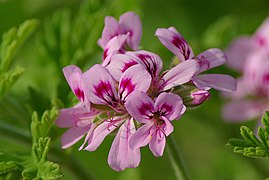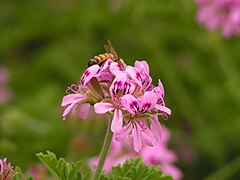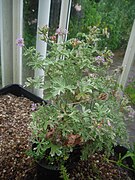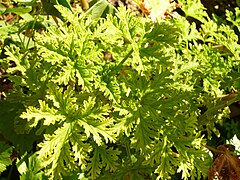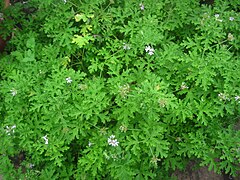Pelargonium graveolens
| Pelargonium graveolens | |
|---|---|

| |
| Scientific classification | |
| Kingdom: | Plantae |
| Clade: | Tracheophytes |
| Clade: | Angiosperms |
| Clade: | Eudicots |
| Clade: | Rosids |
| Order: | Geraniales |
| Family: | Geraniaceae |
| Genus: | Pelargonium |
| Species: | P. graveolens
|
| Binomial name | |
| Pelargonium graveolens L'Hér.[1] | |
Pelargonium graveolens is a Pelargonium species native to the Cape Provinces and the Northern Provinces of South Africa, Zimbabwe and Mozambique.[1]
Etymology
Pelargonium comes from the Greek πελαργός pelargos which means stork. Another name for pelargoniums is stork's-bills due to the shape of their fruit.[2][3] The specific epithet graveolens refers to the strong-smelling leaves.[4]
Description
Pelargonium graveolens is an erect, multi-branched shrub, that grows up to 1.5 m and has a spread of 1 m. The leaves are deeply incised, velvety and soft to the touch (due to glandular hairs). The flowers vary from pale pink to almost white and the plant flowers from August to January. The leaves may be strongly rose-scented, although the leaf shape and scent vary. Some plants are very strongly scented and others have little or no scent. Some leaves are deeply incised and others less so,[5] being slightly lobed like P. capitatum.
Common names and synonyms
Common names include rose geranium,[1][6] sweet scented geranium,[7] old fashion rose geranium,[6] and rose-scent geranium.[1]
Pelargonium graveolens is also known by taxonomic synonyms Geranium terebinthinaceum Cav. and Pelargonium terebinthinaceum (Cav.) Desf.[1] "Rose geranium" is sometimes used to refer to Pelargonium incrassatum (Andrews) Sims or its synonym Pelargonium roseum (Andrews) DC. – the herbal name.[8] Commercial vendors often list the source of geranium or rose geranium essential oil as Pelargonium graveolens, regardless of its botanical name.
Cultivars and hybrids
This article needs additional citations for verification. (July 2015) |
Many plants are cultivated under the species name "Pelargonium graveolens" but differ from wild specimens as they are of
- P. 'Graveolens' (or Pelargonium graveolens hort.) - A rose-scented cultivar; possibly a hybrid between P. graveolens and P. radens or P. capitatum.[10] This cultivar is often incorrectly labeled as Pelargonium graveolens (the species).[11] The main difference between the species and this cultivar is the dissection of the leaf.[12] The species' has about 5 lobes but the cultivar has about 10.
- P. 'Citrosum' - A lemony, citronella-scented cultivar, similar to P. 'Graveolens'.[9] It is meant to repel mosquitos and rumour has it that it was made by genetically bonding genes from the citronella grass but this is highly unlikely.[13]
- P. 'Cinnamon Rose' - A cinnamon-scented cultivar.[14]
- P. 'Dr Westerlund' - A lemony rose-scented cultivar, similar to P. 'Graveolens'.[15]
- P. 'Graveolens Bontrosai' - A genetically challenged form; the leaves are smaller and curl back on themselves and the flowers often do not open fully. Known as P. 'Colocho' in the US.[16]
- P. 'Grey Lady Plymouth' [17]- A lemony rose-scented cultivar similar to P. 'Lady Plymouth'. The leaves are grey–green in colour.[18]
- P. 'Lady Plymouth' - A minty lemony rose-scented cultivar. A very popular variety with a definite mint scent. Possibly a P. radens hybrid.[19]
- P. 'Lara Starshine' - A lemony rose-scented cultivar, similar to P. 'Graveolens' but with more lemony scented leaves and reddish pink flowers. Bred by Australian plantsman Cliff Blackman.[20]
- P. 'Lucaeflora' - A rose-scented variety, much more similar to the species that most other cultivars and varieties.[21]
- P. × melissinum - The lemon balm pelargonium (lemon balm - Melissa officinalis). This is a hybrid between P. crispum and P. graveolens.[22]
- P. 'Mint Rose' - A minty rose-scented cultivar similar to P. 'Lady Plymouth' but without the variegation of the leaves and lemony undertones.[23]
- P. 'Secret Love' - An unusual eucalyptus-scented cultivar with pale pink flowers.[24]
- P. 'Van Leeni' - A lemony rose-scented cultivar, similar to P. 'Graveolens' and P. 'Dr Westerlund'.[25]
Others known; Camphor Rose, Capri, Granelous and Little Gem.[17]
Uses
This article needs additional citations for verification. (May 2012) |
Both the true species and the cultivated plant may be called rose geranium and teas. In addition, it is used as a flavoring agent in some pipe tobaccos, being one of the characteristic "Lakeland scents."
Rose geranium, known as Mâatercha or Ätarcha [29] in Morocco, is used as a flavorful herb to complement spearmint tea. It is often added alongside spearmint or other minty herbs to enhance the overall flavor profile of the tea, adding a floral and aromatic note to the brew.
In Cyprus, where it is known as kiouli, it is used to flavour and scent the sugar syrup in apricot preserves, known as glyko tou koutaliou hrisomilo.[citation needed]
Chemical constituents of geranium oil

A modern analysis listed the presence of over 50 organic compounds in the essential oil of P. graveolens from an Australian source.[30] Analyses of Indian geranium oils indicated a similar phytochemical profile,[31] and showed that the major constituents (in terms of % composition) were citronellol + nerol and geraniol.[32][33]
Gallery
-
The flower cluster of cultivated P. 'Graveolens'
-
A bee on a flower cluster of cultivated P. 'Graveolens'
-
At Ryton Organic Gardens, near Rugby, Warwickshire.
-
Pelargonium 'Graveolens' leaf
-
An adult Pelargonium 'Mint Rose' at Ryton Organic Gardens, near Rugby, Warwickshire
References
- ^ a b c d e f "Pelargonium graveolens". Germplasm Resources Information Network. Agricultural Research Service, United States Department of Agriculture. Retrieved 23 June 2007.
- ^ Dillenius 1732, De Geraniorum Differentiis.
- ^ Boddy 2013, Introduction p. 11.
- ^ J. D. Douglas and Merrill C. Tenney Zondervan Illustrated Bible Dictionary, p. 1150, at Google Books
- ^ S. L. Kochhar Economic Botany (2016), p. 597, at Google Books
- ^ a b "Pelargonium graveolens". Plants For A Future. Accessed June 23, 2007.
- ^ USDA NCRS. "PLANTS Profile for Pelargonium graveolens (sweet scented geranium)". United States Department of Agriculture (USDA), Natural Resources Conservation Service (NCRS), PLANTS Database. Accessed June 23, 2007.
- ^ "Pelargonium incrassatum". Plants For A Future. Accessed June 23, 2007.
- ^ a b "Pelargoniums: An Herb Society of America Guide".
- ISSN 0254-6299.
- ^ "Pelargonium graveolens Rose Geranium, Sweet scented geranium PFAF Plant Database". pfaf.org. Retrieved 8 June 2022.
- ^ "Plant Morphology - an overview | ScienceDirect Topics". www.sciencedirect.com. Retrieved 8 June 2022.
- ^ "Mosquito Repellent Plants". hortnews.extension.iastate.edu. Retrieved 8 June 2022.
- ^ Shoot. "Ocimum basilicum 'Cinnamon' Sweet basil Common basil Cinnamon basil Care Plant Varieties & Pruning Advice". www.shootgardening.co.uk. Retrieved 4 May 2022.
- ^ Varney, Bill (29 May 2012). "Scented Geranium". URBANherbal. Retrieved 4 May 2022.
- ^ "Trichostema dichotomum (Blue Curls, Common Blue-curls, Forked Bluecurls) | North Carolina Extension Gardener Plant Toolbox". plants.ces.ncsu.edu. Retrieved 4 May 2022.
- ^ a b Gary Allen The Herbalist in the Kitchen, p. 175, at Google Books
- ^ "Scented Leaf Pelargoniums: All you need to know and more". Marin Art and Garden Center. 11 October 2021. Retrieved 8 June 2022.
- PMID 31504760.
- ^ The Journal of horticulture, cottage gardener and country gentlemen. LuEsther T. Mertz Library New York Botanical Garden. London : George W. Johnson and Robert Hogg. 1861.
{{cite book}}: CS1 maint: others (link) - ^ "15 Recommended Rose Varieties". The Spruce. Retrieved 4 May 2022.
- ^ "Herbs in Southern Gardens | UGA Cooperative Extension". extension.uga.edu. Retrieved 4 May 2022.
- ^ "GARDENING : Geraniums Make Perfect Scents". Los Angeles Times. 15 August 1992. Retrieved 4 May 2022.
- ^ no_name12 (8 October 2020). "Types of Eucalyptus Trees: Leaves, Flowers, Bark (Pictures)". Leafy Place. Retrieved 4 May 2022.
{{cite web}}: CS1 maint: numeric names: authors list (link) - ^ "15 of the Best Scented Geranium Varieties | Gardener's Path". Gardener's Path. 23 June 2021. Retrieved 4 May 2022.
- ^ "Geranium (Pelargonium) | San Diego Zoo Animals & Plants". animals.sandiegozoo.org. Retrieved 8 June 2022.
- ^ Georges M. Halpern and Peter Weverka The Healing Trail: Essential Oils of Madagascar (2003) at Google Books
- ^ "Scented Geranium". The Epicentre. Retrieved 14 January 2016.
- ISBN 979-8860829343.)
{{cite book}}: CS1 maint: date and year (link - ^ R. A. Shellie and P. J. Marriott (2003). "Comprehensive two-dimensional gas chromatography-mass spectrometry analysis of Pelargonium graveolens essential oil using rapid scanning quadrupole mass spectrometry." Analyst 128 879-883.
- PMC 7122831.
- ^ N. Jain, K. K. Aggarwal, K. V. Syamasundar, S. K. Srivastava and S. Kumar (2001). "Essential oil composition of geranium (Pelargonium sp.) from the plains of Northern India." Flavour and Fragrance J. 16 44–46.
- ^ R. Gupta, G. R. Mallavarapu, S. Banerjee and S. Kumar (2001). "Characteristics of an isomenthone-rich somaclonal mutant isolated in a geraniol-rich rose-scented geranium accession of Pelargonium graveolens." Flavour and Fragrance J. 16 319–324.

